1. Carpenter ants
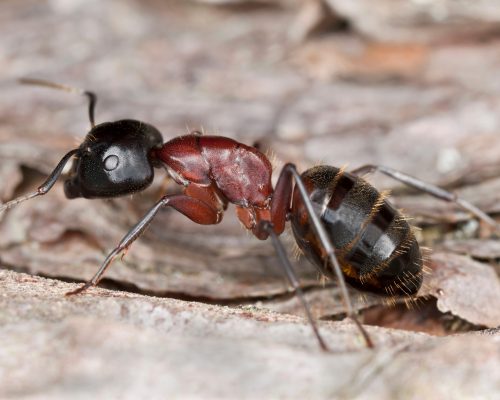
Many people confuse carpenter termites with ants. And not without good reason.
For one, their bodies resemble one another. Both insects have antennas, a tiny body, and six legs.
Also, both carpenter ants and termites live in wood.
Termites eat wood, while carpenter ants will tunnel into wood to create their nest and colonies.
Carpenter ants enjoy being in moist, damaged wood similar to termites.
You can typically find carpenter ant nests in decaying wood on windows, door frames, and wall voids.
So how do you differentiate the two insects?
One of the easiest ways to identify between a carpenter ant and some termites is their color.
Carpenter ants are typically red, black, or a combination of both.
Subterranean termites, on the other hand, are cream-colored and pale.
Dampwood termites have colors ranging from yellowish-brown to cinnamon-brown.
A drywood termite has colors that can vary between tan to dark brown.
Also, carpenter ants have bent antennae and pinched bodies.
Termites, on the other hand, have straight antennae and relatively straight bodies.
You can also sometimes find carpenter ants out in the open, in search of food.
Since carpenter ants don’t eat wood, they leave their nest in search for food.
But termites stay in their hiding spaces unless disturbed or are ready to mate. During mating seasons, you will see flying termites in a swarm.
2. Acrobat ants
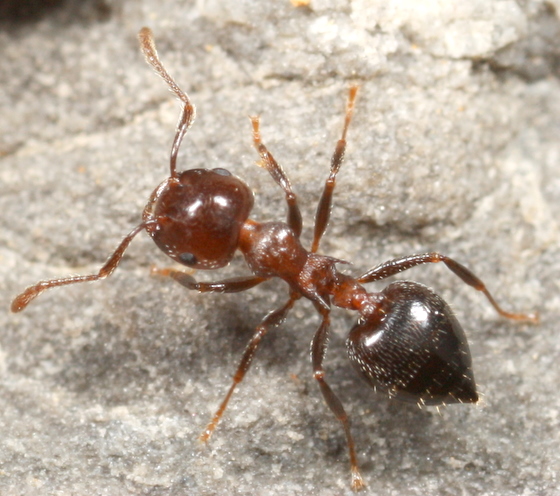
Acrobat ants share many similarities with termites.
Similar to termites, they have small bodies, antennae, and six legs.
They also nest in wood, just like termites.
But, unlike termites, Acrobat ants have bent antennae.
They also have large heads, a skinny waist, and a huge abdomen.
They are also distinct from termites because you’ll typically find them near wirings and pipes.
You will also often see a line of these ants in an infestation—something you wouldn’t observe with termites.
3. Flying ants
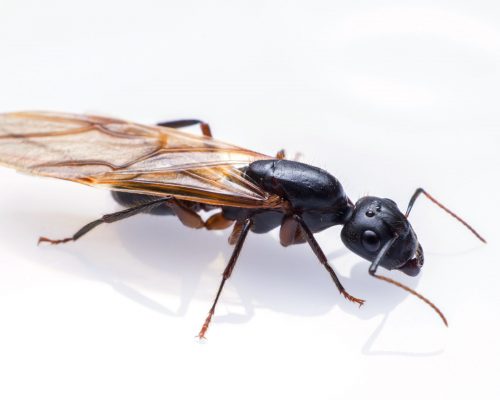
Flying ants are commonly confused with flying termites.
Both have tiny bodies with two pairs of wings.
But, unlike termites, flying ants have bent antennae and pinched bodies.
Their wings are also shorter, unequal length, and more proportionate to their bodies.
Termites, on the other hand, have wings that are equal in length and twice as long as their bodies.
Trying to identify an ant or termite mid-flight is nearly impossible.
4. Longhorned Beetles
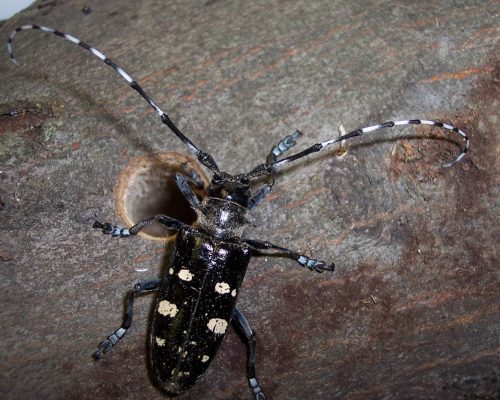
Longhorned Beetles are often confused with termites because their larvae live in wood.
While they typically infest trees, these beetles can infest your house or wood furniture.
Longhorn beetles lay their larva inside a wood.
To do this, they create a small hole at around ⅛ inch thick.
These holes can look very similar to drywood termite kick-out holes.
Their early stage larva also resembles termites with its cream-like color and light brown at the tips.
To identify if termites or long-horned beetles created the holes in your home, look for traces of termite dropping or pellets next to the holes.
Pellets, a.k.a frass, are hexagonal, egg-shaped granules.
They look like sand or coffee ground and feel a little rough if stepped on.
You can also expect these holes to be significantly larger than termites.
5. Powderpost Bettles
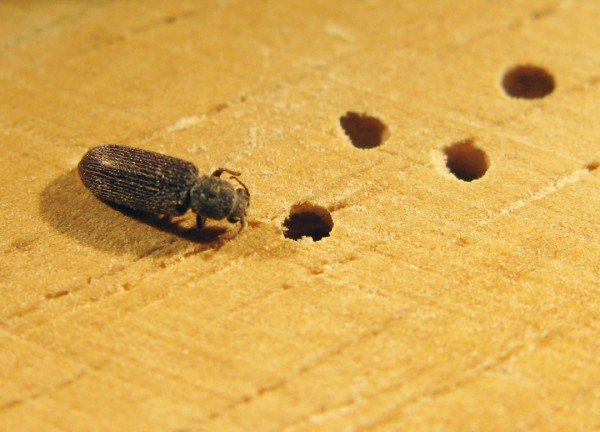
While adult beetles and adult termites are easy to distinguish, their larva is not always the case.
Similar to termites, Powderpost beetle larva is light and tan in color and lives inside the wood.
Their larva also leave holes and sawdust that highly resemble that of drywood termites’ kick-out tunnels.
To identify if termites or Powderpost Bettles beetles created the holes in your home, look for traces of termite pellets next to the holes.
Pellets, a.k.a frass, are termite droppings.
They look like sand or coffee ground and feel a little rough if stepped on.
You can also expect these holes to be significantly larger than termites.
6. Carpenter Bees
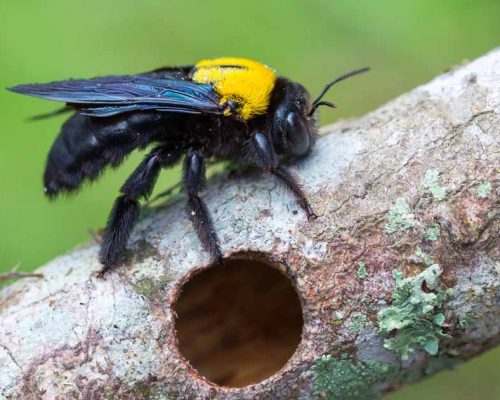
Like termites, carpenter bees infest wood and leave sawdust-like debris around the wood their infesting.
But, unlike termites, they do not feed on the wood.
Instead, they drill tunnels inside of wood to make their nest.
Carpenter ants typically drill holes in porches, sheds, door frames, fences, windowsills, and outdoor furniture.
These tunnels can be as wide as 1/2 inch wide and 6-10 inches long.
Carpenter bees don’t typically cause severe structural damage.
This only happens with large infestations after years of successive drilling tunnels.
These networks of tunnels can grow up to 10 feet long over time.
As such, a prolonged infestation can compromise the integrity of the wood.
This is unlikely to happen to your home without you noticing.
In most cases, the damage caused by the carpenter bees is mainly superficial and can be repaired quite easily.
An easy way to tell the difference between a carpenter bee and termite infestation by inspecting the holes they leave behind.
Carpenter bees leave much larger, round holes than termites. In contrast, termite kick-out holes are smaller and not as round.
Carpenter bees holes are also few and far apart. But, termite kick-out holes come in dozens and are more bunched up together.
7. Silverfish
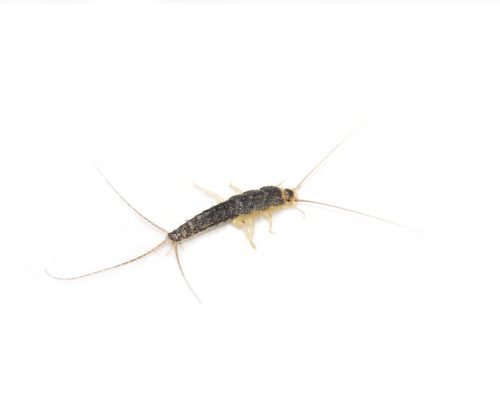
Silverfish have often mistaken them for termite.
Just like termites, they are tiny insects who are notorious for their destructive feeding habits.
But unlike termites, they do not feed on and live inside the wood.
Silverfish prefer to dwell in dark, damp areas such as basements, attics, kitchens, and bathrooms.
They thrive on softer cellulose materials such as starch, glue, cardboard, shampoos, and books. They also like damp fabrics.
In terms of appearance and behavior, they are quite different too.
While silverfish aren’t fish, they have scales and move in a side-to-side motion like swimming.
Silverfish are fast-moving insects that move with a snake-like motion.
In contrast, termites crawl with their legs.
7. Earwig
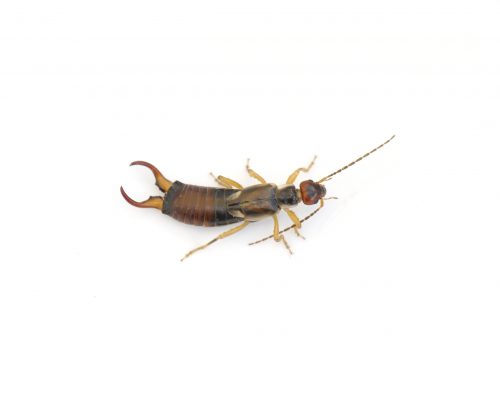
Earwigs and termites both have tiny, segmented bodies with six legs.
That said, there are many differences between these two insects.
First, termites have a hierarchy caste system. They have a king, queen, workers, and soldiers.
In contrast, Earwigs do not have a social structure or castes.
Earwigs are also dark brown to black. Termites, on the other hand, are usually light in color.
Also, unlike termites, Earwigs don’t cause wood damage.
They also move much faster than termites.
FAQ
What do termites look like?
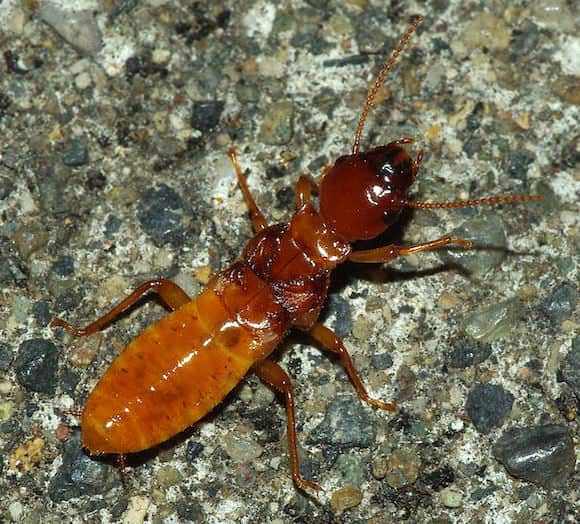
Dampwood
Dampwood termites grow up to ¾” long.
They are much larger than both the Subterranean and Drywood termites.
They have colors ranging from yellowish-brown to cinnamon-brown.
They also have a flat brown head and long dark brown to black mandibles.
Their Reproductives, also known as Alates, are dark brown with brown wings.
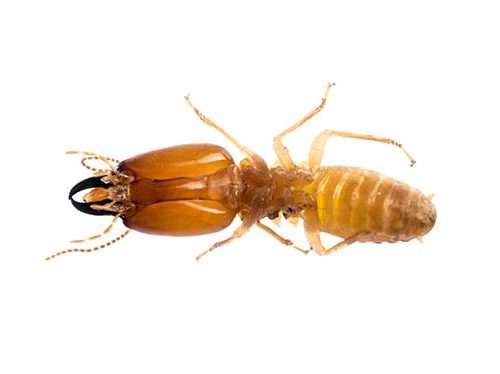
Drywood
Drywood termites can vary from light brown to dark brown in color with the head darker than the rest of the body.
They are the second biggest termite, at around 3/8 to 2/3 of an inch.
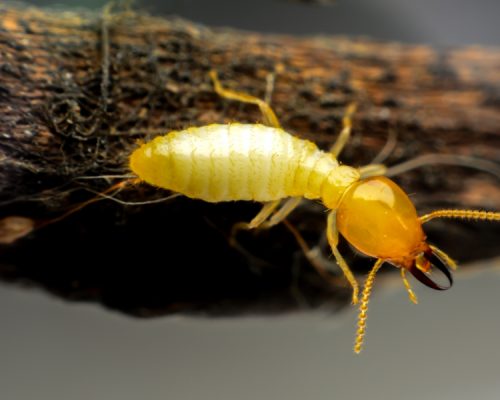
Subterranean
Subterranean termites have a long, narrow, white body that’s about 1/8 inch long.
Their head can be light orange to dark brown. They have 6 legs and 2 straight antenna.
What are signs of a termite infestation?
To identify termite infestations, watch out for:
Mud Tubes
Mud tubes are made of termite droppings, soil, saliva, and wood.
These tubes help protect termites when traveling between food and the nest.
Mud tubes take on different forms: working tube, exploratory tube, and drop tubes.
The working tube and exploratory tube look like veins running up against your wall.
Drop tubes look like calcium deposits that hang in caves. Except they hang from the ceiling.
Uneven or Bubbling Paint
Uneven or bubbling paint could be a sign of termite damage.
Frass / Droppings
If you find a small pile of what looks like pellets inside or outside the home, it could sign termite infestation.
Weird Noises
If you hear a quiet clicking sound coming from the walls, it could be a sign of termite infestation.
When worker termites eat your woodwork, they make noises.
You can typically hear them eating if you place your ear against your walls.
Hollow wood
Termites devour wood from the inside out, leaving a weak shell.
As such, when you knock on an area that has termite damage, it will sound hollow.
Flying Termites or Swarmers
Flying termites signify a termite population is ready to expand into new colonies.
Are termites Dangerous?
Termites cannot physically harm you, but they are dangerous in other ways.
These pests feed on the wood structure of your home from the inside out.
By doing so, they leave your floors, ceilings, and walls prone to collapse.
How do termites get into my house?
Termites can crawl into your home through the tiniest of spaces.
These little insects can get through a hole as small as 1/32nd of an inch.
That said, different termites tend to enter your house in different ways.
Subterranean termites, for instance, will generally enter your house along its foundation and around your plumbing.
They can also enter through cracks in your patios and chimneys.
Dampwood termites enter your house through infested lumber and mulch.
Swarmers will also sometimes enter your house because they are attracted to light.
If you leave your outdoor light on and there are swarmers around, the swarmers will likely come to your house.
Once the swarmers are inside, they will settle on damp wood and begin a new colony.
Drywood termites typically enter the home through swarmers.
Swarmers will typically fly directly onto the wood on your home and begin to start their colonies.
They typically don’t enter through the soil since they can and prefer to eat dry wood.
How long do termites live?
A worker and soldier termite lives for one to two years.
Female reproductive will go on to become a queen of a new colony and live up to 50 years.
Do Termites have wings?
Only one type of termite in a colony has wings–the reproductives.
Reproductives are also known as swarmer or Alates.
Their primary purpose is to reproduce. They are future kings and queens of termite colonies.
Alates fly to leave the nest to start new colonies. They lose their wings soon after they mate.
Can termites get through concrete?
Termites cannot eat or chew through solid concrete.
But, they can get through cracks as small as 1/32nd of an inch.
Cracks between the foundation and corners of your home typically offer plenty of space for termites to get it.
Do Termites eat wood?
Yes. Termites feed and thrive on wood.
Some termites turn wood into construction tools after digesting its nutrients.
They turn their feces (pellets) into tunnels and structures that protect their colonies from predators and the environment.
These wood eating insects also play an essential role in nature.
By turning wood into the dirt, they nourish the soil and provide nutrients to plants.
That said, termites will eat anything containing cellulose.
That includes cardboard, paper, and fabric.
How Can I Identify termite droppings?
Termite droppings vary in appearance depending on the species of termites.
There are three common forms they can take: Pellets, Patches, and Mud tubes.
Pellets:
Pellets look a lot like sand or sawdust.
But unlike sand, a drywood pellet has six concave surfaces.
They are hard, elongated, and less than 1/25 inch long.
Pellets can be different colors, depending on the color of the wood termites have been eating.
In most cases, you can find these pellets next to “kick out” holes.
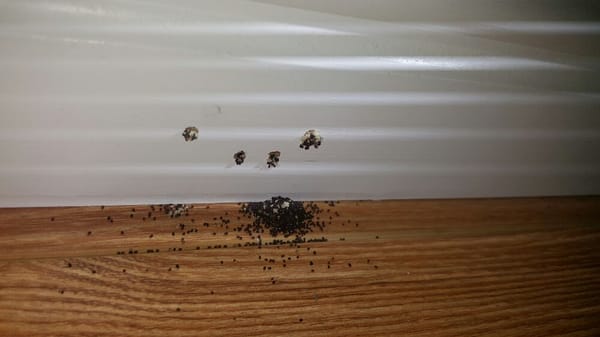
You will typically find termite pellets on doors, windows, floorboards, and under your furniture.
You may also find them around eaves and joints inside attics and basements.
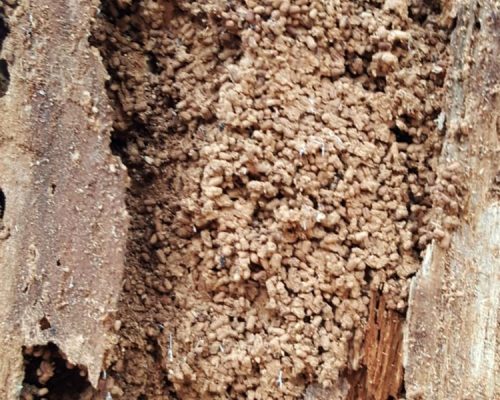
Patches
Seals look like a paste.
Termites use them to seal entry points around their nest.
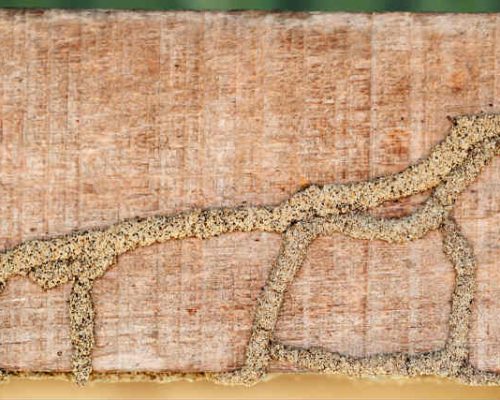
Mud Tubes
Mud tubes are made of termite feces, saliva, and dirt.
They look like veins running up against your wall or calcium deposits suspended in caves.
You’ll find these tubes on or near the soil.
You may find them near your pipes, in your attic, crawlspace, or along your foundation.
Mud tubes typically take on three forms: working tube, exploratory tube, and drop tube.
